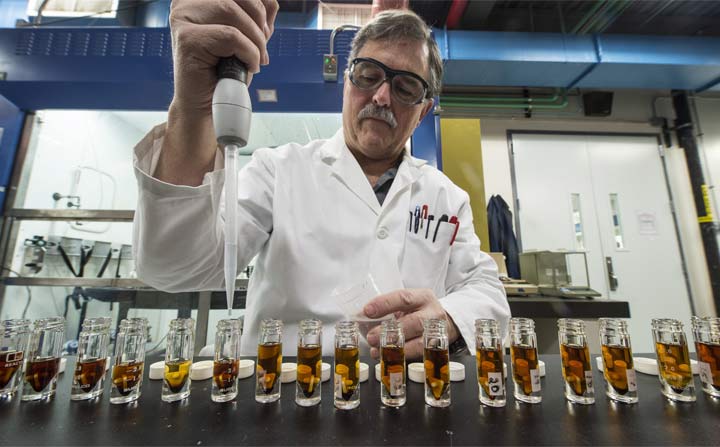First Standard for Chemical Characterization of Bio-Oil Approved by ASTM: NREL Paves the Way Toward Commercialization
The path toward biofuel commercialization became easier with a recent bio-oil standard approval by ASTM International. An Inter-Laboratory Study (ILS) led by the National Renewable Energy Laboratory (NREL) in collaboration with Oak Ridge National Laboratory and Pacific Northwest National Laboratory developed the new standard titled, "Standard Test Method for Determination of Carbonyls in Pyrolysis Bio-Oils by Potentiometric Titration" (E3146). This standard quantifies the total carbonyl content of complex pyrolysis bio-oils through a faster and more reliable titration method.

An NREL scientist works with catalytic fast pyrolysis oil production samples to measure aldehydes and ketones. Photo by Dennis Schroeder
Jack Ferrell, research engineer at NREL’s National Bioenergy Center, explains the significance of ASTM E3146: “This is the first ASTM method for quantifying the chemical composition of pyrolysis bio-oils. The standard will enable industry and research communities to do meaningful analysis and compare different bio-oils prior to upgrading to fuels or chemicals.”
ASTM E3146 offers several enhancements over the previous carbonyl titration method. For example, performing sample preparation at higher temperatures—80°C compared to room temperature—enhances the accuracy of quantifying the amount of carbonyl in bio-oils because room temperature reactions consistently under-predicted carbonyl content. Another enhancement includes reduction in analysis time from 24 hours to 2 hours, contributing to a significantly higher sample throughput. ASTM E3146 also improves reliability demonstrating just 5% variability during the ILS study. Numbers below 5% are promising for bio-oil analysis because lower variabilities in the ILS mean the method is more robust.
Quantifying carbonyl content of bio-oils is crucial for the bioeconomy. Bio-oils are known to undergo an aging process over time, leading to changes in both physical and chemical properties. During aging, carbonyl groups chemically react in bio-oil—leading to an increase in viscosity and a decrease in carbonyl content during storage. ASTM E3146 has allowed a new aging test to be developed based on tracking carbonyl content during accelerated aging at 80°C and comparing it to actual long-term storage at room temperature. This new accelerated aging test will help determine how long a bio-oil sample can be stored before downstream processing becomes prohibitive.
During upgrading processes used to produce biofuels from bio-oils, the presence of carbonyls can contribute to catalyst coking. If a catalyst cokes, catalyst performance degrades and catalyst regeneration is required, resulting in process downtime and an increase in the cost of energy and reactants needed to regenerate. Significant coking leads to reactor plugging, where the reactor must be physically removed and cleaned, increasing costs and downtime. Quantifying carbonyl through ASTM E3146 can be used to determine the extent of catalyst coking that will occur during upgrading. Using ASTM E3146, researchers determined that if the carbonyl content of a raw fast pyrolysis bio-oil was greater than 1.5 moles/kilogram, the high-temperature hydrotreater would plug. This allowed researchers to prevent reactor plugging by further reducing carbonyl content (to below 1.5 moles/kilogram) with additional low-temperature hydrotreatment.
"All things considered, ASTM E3146 is good news for the bioeconomy. Researchers can use this method to make meaningful comparisons between bio-oils produced by different conditions, and in different facilities. Furthermore, industry working with bio-oils requires standardized methods from an agency such as ASTM to enable commerce with bio-oils,” Ferrell said.
Learn more about NREL's bioenergy research.

